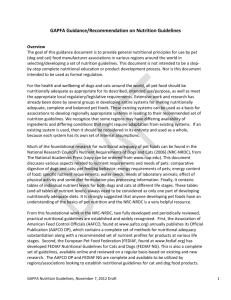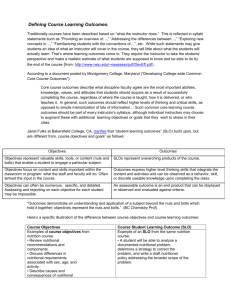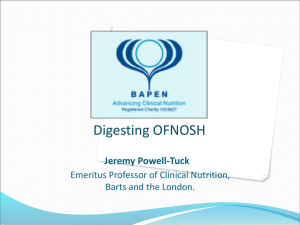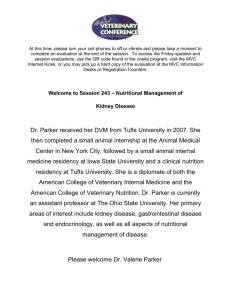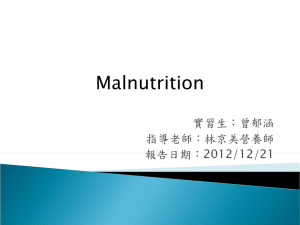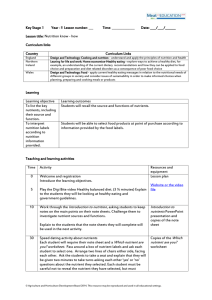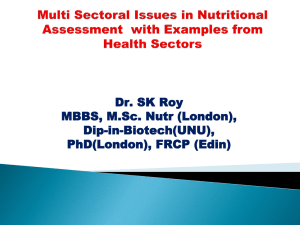GAPFA-Nutrition Workstream Teleconference 27 June 2012
advertisement
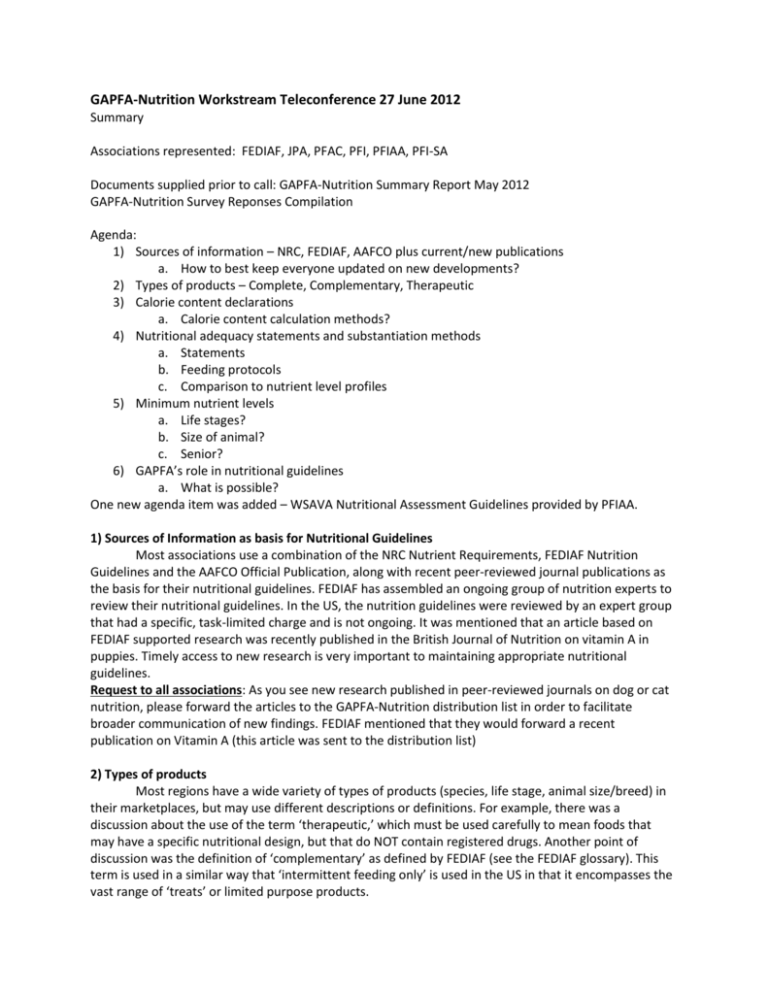
GAPFA-Nutrition Workstream Teleconference 27 June 2012 Summary Associations represented: FEDIAF, JPA, PFAC, PFI, PFIAA, PFI-SA Documents supplied prior to call: GAPFA-Nutrition Summary Report May 2012 GAPFA-Nutrition Survey Reponses Compilation Agenda: 1) Sources of information – NRC, FEDIAF, AAFCO plus current/new publications a. How to best keep everyone updated on new developments? 2) Types of products – Complete, Complementary, Therapeutic 3) Calorie content declarations a. Calorie content calculation methods? 4) Nutritional adequacy statements and substantiation methods a. Statements b. Feeding protocols c. Comparison to nutrient level profiles 5) Minimum nutrient levels a. Life stages? b. Size of animal? c. Senior? 6) GAPFA’s role in nutritional guidelines a. What is possible? One new agenda item was added – WSAVA Nutritional Assessment Guidelines provided by PFIAA. 1) Sources of Information as basis for Nutritional Guidelines Most associations use a combination of the NRC Nutrient Requirements, FEDIAF Nutrition Guidelines and the AAFCO Official Publication, along with recent peer-reviewed journal publications as the basis for their nutritional guidelines. FEDIAF has assembled an ongoing group of nutrition experts to review their nutritional guidelines. In the US, the nutrition guidelines were reviewed by an expert group that had a specific, task-limited charge and is not ongoing. It was mentioned that an article based on FEDIAF supported research was recently published in the British Journal of Nutrition on vitamin A in puppies. Timely access to new research is very important to maintaining appropriate nutritional guidelines. Request to all associations: As you see new research published in peer-reviewed journals on dog or cat nutrition, please forward the articles to the GAPFA-Nutrition distribution list in order to facilitate broader communication of new findings. FEDIAF mentioned that they would forward a recent publication on Vitamin A (this article was sent to the distribution list) 2) Types of products Most regions have a wide variety of types of products (species, life stage, animal size/breed) in their marketplaces, but may use different descriptions or definitions. For example, there was a discussion about the use of the term ‘therapeutic,’ which must be used carefully to mean foods that may have a specific nutritional design, but that do NOT contain registered drugs. Another point of discussion was the definition of ‘complementary’ as defined by FEDIAF (see the FEDIAF glossary). This term is used in a similar way that ‘intermittent feeding only’ is used in the US in that it encompasses the vast range of ‘treats’ or limited purpose products. GAPFA-Nutrition Agreement: The focus will be on complete products for healthy animals. 3) Calorie Content – Methods for determining calorie content in pet foods are under ongoing discussion in several regions. FEDIAF is in the midst of considering a recommendation on the calculation method for calories. They are discussing the Modified Atwater’s equation and an equation based on the 2006 NRC publication. Their next meeting on it is July 5. The equation used for calculation in the US is the AAFCO Modified Atwater’s equation. Calories can also be determined via feeding trials. Other regions provide the option of using Modified Atwater’s or feeding trials. Request to FEDIAF: Please provide to GAPFA-Nutrition the outcomes of the discussions on calorie calculation. 4) Nutritional Adequacy Substantiation – Several regions use the AAFCO approach to substantiation, which provides the choice between comparisons to nutrient profiles or completion of feeding protocols. FEDIAF recommends a comparison to nutrient profiles in combination with digestibility trials based on the assumptions that the profiles were set using a 70% dry matter digestibility and an 80% protein digestibility. In Australia the expectation is that the manufacturer will make a product suitable for its purpose and will have adequate substantiation for that position. 6) GAPFA: Goals, Scope, Principles, Mechanisms, Outcomes – Several questions were raised about the goals, scope, operating mechanisms and potential outcomes of the GAPFA-Nutrition Workstream as well as for GAPFA overall. Questions were also raised about the potential interconnectivity of the work streams and GAPFA as a whole. One suggestion was that GAPFA-Nutrition identify the well-established principles of nutrition that make up nutritional guidelines as an outcome. Another comment was to continue to look at technical issues and not legal (or regulatory) issues. Another request was that we as the Nutrition group identify what questions and/or comments we have for the broader GAPFA group to be raised in the November meeting. GAPFA Mission Statement – “To support the health and wellbeing of pets and to promote the benefits of living with them, through the development of consensus based guidance for the global pet food industry, thereby enhancing its sustainability and credibility.” GAPFA Nutrition Workstream Objective per Oct. 4, 2012 Minutes – To provide practical guidance to industry for producing nutritionally balanced pet food for maintaining the health of cats and dogs supported by international experts and recognised as a reference document. The teleconference closed before reaching items 5 - Minimum Nutrient Levels and 7 - Nutritional Assessment Guidelines, so those items along with items generated from the call will be discussed on the next teleconference. Next Teleconference Discussion items: 1 – Minimum Nutrient Levels Existing reference nutrient profiles Factors in determining nutrient values in profiles 2 – Nutritional Assessment Guidelines WSAVA document for veterinary clinics Awareness/ Promotion? 3 – GAPFA – Goals, Scope, Mechanisms, Outcomes Scope/Outcomes - Practical guide on nutrition? Globally recognized? Questions for Vancouver – How to reach consensus?
